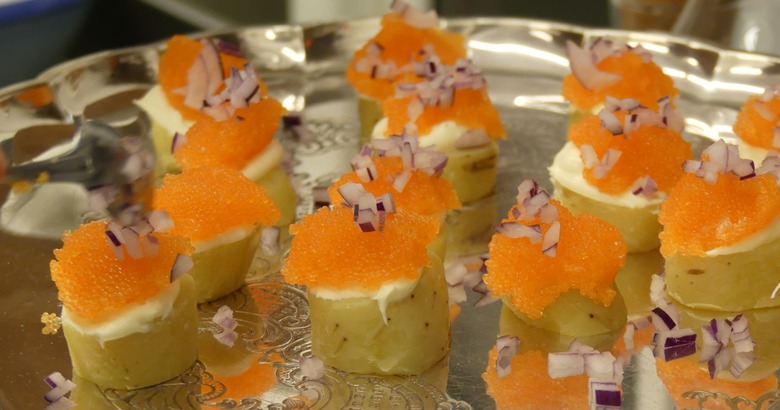Sweden's Vendace 'Caviar' Is A Nobel Prize-Level Delicacy
Kalix löjrom, the "caviar," or roe, of several species of European freshwater whitefish of the genus Coregonus — most notably vendace (Coregonus albula)— is a highly prized delicacy in Sweden. Fished primarily in the Bottenviken, or Bay of Bothnia, in the northeastern reaches of the country (an area promoted as Swedish Lapland for tourism purposes, though it isn't within the province of that name) — it is almost inevitably served at important banquets in that country, including weddings and Nobel Prize dinners. In 2010, the EU recognized the roe's uniqueness by granting it Protected Geographical Status — a category shared by such other notable products as Champagne, Roquefort cheese, jamón serrano, and traditional balsamic vinegar.
Pär Innala, the 39-year-old communications manager for the Swedish Ecotourism Association and also an avid fisherman, explains why this roe is so special. "On the Swedish side of Bottenviken," he says, "there is a unique sea and archipelago environment, as the big rivers — the Kalix, Åby, Pite, Lule, Råne, Töre, Sangis, and Torne — bring fresh water from the mountains down to the bay. It makes it one of the world's most significant seawater areas with a salt content of only 0.3 percent. The sea is also full of minerals [among them, strontium, iodine, selenium, bromine, and lithium], as the melting water brings them from the bedrock of the mountains. The freshwater supply is so massive that the whole sea is circulated every three years and the clean water, with its low salinity, creates the perfect conditions for the vendace to live and breed." The same conditions also give their roe a unique flavor.
The bay is rich in fish, including not just vendace but also another species of whitefish (Coregonus lavaretus), as well as salmon, trout, Baltic herring, perch, pike, and burbot. Innala — who comes from a long line of fishermen, he says, and has been fishing his whole life — lands mostly salmon and whitefish, but sometimes vendace as well. "Since 2015, I've made my commercial fishing license," he says, "but it is not my main source of income."
The salmon fishery in the Bay of Bothia is well-regulated, and fished on a quota basis. The vendace fishery was certified as sustainable in 2015 by the Marine Stewardship Council and Bureau Veritas (a worldwide inspection and certification agency) and other international bodies, and, says Innala, "For vendace, we will likely see regulations in place for next fishing season."
That season begins on September 20, and lasts about five weeks, depending on water temperature and other factors. Around three million pounds of the fish are taken every year, separated by hand according to sex. The fish are typically about six to eight inches long, with each female carrying no more than about a tenth to a fifth of an ounce of roe. After it's removed, the roe is rinsed, dried, and salted, then usually frozen. The laboriousness of the process accounts for its comparative rarity, and its price — officially about $425 a kilo ($193 a pound), though Innala says that, with the right contacts, a kilo can be had from a local fisherman for around $145.
There are 70 licensed fishermen, more or less, in Swedish Lapland, he adds, but a license to take vendace is only required for trawlers. Those who use nets or traps don't need a license.
"I would say that the local fishermen take pride in the craftsmanship that is behind producing Kalix löjrom," adds Innala. "Also, it is a symbol that we can produce something good enough for the Nobel Prize dinner. I think this has been something that sparked the whole Swedish Lapland area to be prouder of our local pantry — which is awesome, by the way."
Gunhild Stensmyr, owner of the Arthotel in Tornedalen, on the Torne River, is a champion of local specialties, serving her international clientele such things as moose and reindeer meat, and "When it comes to fish, whitefish and salmon from the Torne and if possible pike-perch from nearby lakes."
Gunhild has fond memories of Kalix löjrom. 'We had fresh löjrom, not frozen," she recalls, "for breakfast during the fishing season, and ate it on knäckebröd [crispbread] with chopped yellow onion. We all loved it. We did not only eat the roe, we actually ate the whole fish, boiled."
Times have changed, she says. The roe is available, but too expensive to eat every day. "Major migration from Tornedalen since '60s and '70s," she says, "has contributed to the fact that not many people fish here any longer. The migrations mean that everyday life and traditions are in constant change. Small-scale family-based fishing has almost completely ceased. We have to buy the roe now like everyone else and at the same price."
What does Kalix löjrom taste like? "Ooooh, tough one," says Pär Innala. "The taste is mild and delicious, salt and sea."
Kalix löjrom is sometimes available, frozen, by mail order in the U.S.
